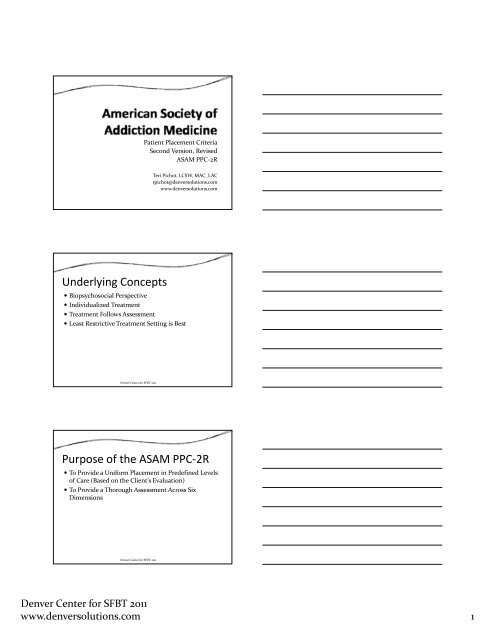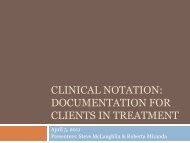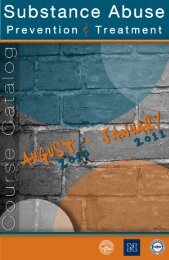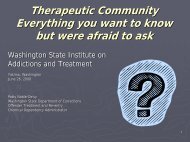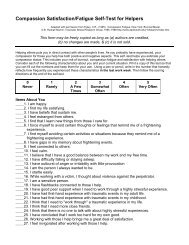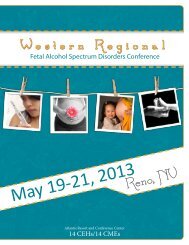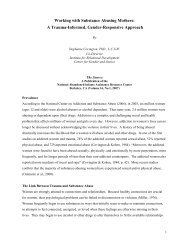Underlying Concepts Purpose of the ASAM PPC-2R - CASAT
Underlying Concepts Purpose of the ASAM PPC-2R - CASAT
Underlying Concepts Purpose of the ASAM PPC-2R - CASAT
Create successful ePaper yourself
Turn your PDF publications into a flip-book with our unique Google optimized e-Paper software.
Patient Placement Criteria<br />
Second Version, Revised<br />
<strong>ASAM</strong> <strong>PPC</strong>‐<strong>2R</strong><br />
Teri Pichot, LCSW, MAC, LAC<br />
tpichot@denversolutions.com<br />
www.denversolutions.com<br />
<strong>Underlying</strong> <strong>Concepts</strong><br />
• Biopsychosocial Perspective<br />
• Individualized Treatment<br />
• Treatment Follows Assessment<br />
• Least Restrictive Treatment Setting is Best<br />
Denver Center for SFBT 2011<br />
<strong>Purpose</strong> <strong>of</strong> <strong>the</strong> <strong>ASAM</strong> <strong>PPC</strong>‐<strong>2R</strong><br />
• To Provide a Uniform Placement in Predefined Levels<br />
<strong>of</strong> Care (Based on <strong>the</strong> Client’s Evaluation)<br />
• To Provide a Thorough Assessment Across Six<br />
Dimensions<br />
Denver Center for SFBT 2011<br />
Denver Center for SFBT 2011<br />
www.denversolutions.com 1
DSM‐IV Diagnoses<br />
Substance‐Use Disorders<br />
1. Substance Dependence<br />
2. Substance Abuse<br />
Substance‐Induced Disorders<br />
1. Substance Intoxication<br />
2. Substance Withdrawal<br />
3. Substance‐Induced Mental Disorders<br />
Denver Center for SFBT 2011<br />
Levels <strong>of</strong> Care<br />
I. Outpatient Care<br />
II. Intensive Outpatient/Partial Hospitalization<br />
Services<br />
III. Residential/Inpatient i i Services<br />
IV. Medically‐Managed Intensive Inpatient Services<br />
Denver Center for SFBT 2011<br />
Levels <strong>of</strong> Care (<strong>ASAM</strong> <strong>PPC</strong>‐<strong>2R</strong>)<br />
0.5 Early Intervention<br />
I. Traditional Outpatient<br />
II.1 Intensive Outpatient<br />
II.5 Day Treatment<br />
III.1 Clinically‐Managed Low‐Intensity Residential<br />
Services<br />
III.3 Clinically‐Managed Medium‐Intensity Residential<br />
Services<br />
III.5 Clinically‐Managed High‐Intensity Residential<br />
Services<br />
Denver Center for SFBT 2011<br />
Denver Center for SFBT 2011<br />
www.denversolutions.com 2
Levels <strong>of</strong> Care (cont.)<br />
III.7 Medically‐Monitored Intensive Inpatient Services<br />
IV Medically‐Managed Intensive Inpatient Services<br />
Denver Center for SFBT 2011<br />
Level I<br />
• Less than 9 hours per week <strong>of</strong> structured<br />
programming<br />
• Might be dual diagnosis treatment depending on skill<br />
<strong>of</strong> <strong>the</strong>rapists and program designation<br />
Denver Center for SFBT 2011<br />
Level II<br />
• II.1 Intensive Outpatient<br />
‐9 or more hours per week <strong>of</strong> structured programming<br />
‐Less capacity to address significant medical or<br />
psychiatric problems<br />
• II.5 Partial Hospitalization<br />
‐20 or more hours per week clinically intensive<br />
programming<br />
‐Access to psychiatric, medical, lab services<br />
‐Complications in dimensions 1, 2, or 3 requiring<br />
monitoring can be addressed<br />
Denver Center for SFBT 2011<br />
Denver Center for SFBT 2011<br />
www.denversolutions.com 3
Level III<br />
• III.1 Clinically‐Managed Low Intensity Residential<br />
Services<br />
‐Minimum <strong>of</strong> 5 hours per week <strong>of</strong> treatment services<br />
‐Dimension i 5 and 6 focused<br />
‐Application <strong>of</strong> recovery and interpersonal skills<br />
‐Staffed 24 hours a day<br />
Denver Center for SFBT 2011<br />
Level III (cont.)<br />
• III.3 Clinically‐Managed Medium Intensity<br />
Residential Services<br />
‐Extended or long‐term care<br />
‐Habilitation Hbili i vs. Rehabilitation<br />
Rhbili i<br />
‐Elderly, developmentally delayed, cognitively impaired<br />
‐Slower‐paced, repetitive programming<br />
Denver Center for SFBT 2011<br />
Level III (cont.)<br />
• III.5 Clinically‐Managed High Intensity Residential<br />
Services<br />
‐Therapeutic community<br />
‐Criminal Ci i l justice involvement, anti‐social<br />
il<br />
‐Focus on personal responsibility, social values<br />
‐Token economies, behavioral <strong>the</strong>rapies<br />
‐Highly structured, prescribed activities 24 hours/day<br />
‐<strong>ASAM</strong> <strong>PPC</strong>‐<strong>2R</strong> broadened this category beyond<br />
<strong>the</strong>rapeutic community model<br />
Denver Center for SFBT 2011<br />
Denver Center for SFBT 2011<br />
www.denversolutions.com 4
Level III (cont.)<br />
• III.7 Medically‐Monitored Intensive Inpatient<br />
Treatment<br />
‐More intensive medical services<br />
‐Usually U incorporates detoxification<br />
i<br />
‐Dual diagnosis, conjoint treatment<br />
‐More intensive staffing patterns, support services<br />
Denver Center for SFBT 2011<br />
Level IV<br />
• Medically‐Managed Intensive Inpatient Services<br />
‐Medical needs are primary<br />
‐Hospital‐based services<br />
‐Life support measures available<br />
‐Substance abuse treatment is still given along side<br />
medical care<br />
Denver Center for SFBT 2011<br />
Program Capabilities<br />
• Addiction‐Only Services (AOS)<br />
• Dual Diagnosis Capable (DDC)<br />
‐Staff must be able to provide mental health services<br />
‐Most non‐medication related mental health services<br />
provided or monitored<br />
• Dual Diagnosis Enhanced (DDE)<br />
‐Must have a psychiatrist on staff<br />
‐Staff must be able to provide mental health services<br />
‐All substance abuse/mental health services provided<br />
Denver Center for SFBT 2011<br />
Denver Center for SFBT 2011<br />
www.denversolutions.com 5
Detoxification Services<br />
(Dimension 1)<br />
• I‐D<br />
• II‐D<br />
• III.2‐D<br />
• III.7‐D<br />
• IV‐D<br />
Ambulatory Detoxification without On‐site<br />
Monitoring<br />
Ambulatory Detoxification with Extended<br />
On‐site Monitoring<br />
Clinically‐Managed Residential<br />
Detoxification Services (Social<br />
Detoxification)<br />
Medically‐Monitored Inpatient Detoxification<br />
Services<br />
Medically‐Managed Inpatient Detoxification<br />
Services<br />
Denver Center for SFBT 2011<br />
Dimension 1: Alcohol Intoxication<br />
and/or Withdrawal Potential<br />
• Refers to current situation (not past or if <strong>the</strong> client<br />
uses again)<br />
• Are <strong>the</strong>re current signs or withdrawal<br />
• Is <strong>the</strong>re significant ifi risk ik <strong>of</strong> severe withdrawal ihd (seizures,<br />
DTs)<br />
• Medical Assessment<br />
• CIWA‐Ar Scale or o<strong>the</strong>r objective rating<br />
Denver Center for SFBT 2011<br />
Dimension 2: Biomedical<br />
Conditions and Complications<br />
• Any current physical illnesses (not including<br />
withdrawal) that need to be addressed, or that may<br />
complicate treatment<br />
• Key: That may complicate treatment. Looking for<br />
degree <strong>of</strong> stability.<br />
• Are <strong>the</strong>re chronic conditions that affect treatment<br />
• Axis III on DSM‐IV<br />
• HIV/AIDS Risk<br />
• Pregnancy<br />
Denver Center for SFBT 2011<br />
Denver Center for SFBT 2011<br />
www.denversolutions.com 6
Dimension 3:<br />
Emotional/Behavioral/Cognitive<br />
Conditions and Complications<br />
• Current psychiatric illnesses or psychological,<br />
behavioral, or emotional problems that need to be<br />
addressed or which complicate treatment<br />
• Any chronic conditions that affect treatment<br />
• These are Axis I and Axis II on <strong>the</strong> DSM‐IV<br />
• Major Depression, Dysthymia, Bipolar Disorder,<br />
Borderline Personality Disorder, etc. (i.e., “lying”<br />
would not usually be a dimension 3 issue)<br />
• Key: That may complicate treatment due to lack <strong>of</strong><br />
current treatment and/or stability.<br />
Denver Center for SFBT 2011<br />
Dimension 4: Treatment<br />
Acceptance/Resistance/Readiness<br />
to Change<br />
• Socrates 7A or 7D<br />
• How ready is <strong>the</strong> client to change<br />
• What is <strong>the</strong> client willing to do at this time<br />
• What does <strong>the</strong> client think he/she needs<br />
• External vs. Internal Motivation<br />
• High “Resistance” does not mean a higher level <strong>of</strong> care<br />
Denver Center for SFBT 2011<br />
Dimension 5: Relapse/Continued<br />
Use/Continued Problem Potential<br />
• What is <strong>the</strong> client’s current skill level<br />
• Is it that <strong>the</strong> client won’t or can’t remain substance free<br />
• How long can <strong>the</strong> client remain substance free without<br />
structure<br />
• What worked before Has <strong>the</strong> client tried it recently<br />
• Unresolved grief<br />
• Poor impulsive control/uncontrolled anger (non‐diagnosis)<br />
• Cultural Issues such as mistrust (can also be Dimension 6)<br />
• Is <strong>the</strong>re something that is putting client at increased risk<br />
(not taking psychiatric medication)<br />
Denver Center for SFBT 2011<br />
Denver Center for SFBT 2011<br />
www.denversolutions.com 7
Dimension 6: Recovery<br />
Environment<br />
• Who does <strong>the</strong> client have in his/her life who is<br />
supportive <strong>of</strong> <strong>the</strong> client<br />
• Who does <strong>the</strong> client associate with when he/she is able<br />
to remain substance free<br />
• Who does <strong>the</strong> client live with<br />
• What skills does <strong>the</strong> client have to cope with his/her<br />
living environment<br />
• Does <strong>the</strong> client have basic financial resources,<br />
employment, housing, that will increase likelihood <strong>of</strong><br />
success<br />
Denver Center for SFBT 2011<br />
Dimension 6: Recovery<br />
Environment (cont.)<br />
• Any legal involvement or external pressure (if so, how<br />
does <strong>the</strong> client interpret this)<br />
• Marital/Family Issues<br />
Denver Center for SFBT 2011<br />
Important Points to Remember<br />
• The client must meet DSM‐IV criteria for abuse or<br />
dependency in order to be placed on any level higher<br />
than 0.5.<br />
• You can only cite each issue in one dimension.<br />
• The <strong>ASAM</strong> should be used any time level <strong>of</strong> care is<br />
changed (ei<strong>the</strong>r up or down).<br />
• The <strong>ASAM</strong> <strong>PPC</strong>‐<strong>2R</strong> should be used to justify additional<br />
treatment in <strong>the</strong> same level <strong>of</strong> care.<br />
Denver Center for SFBT 2011<br />
Denver Center for SFBT 2011<br />
www.denversolutions.com 8
Level <strong>of</strong> Care Scenario<br />
• Jose Guillen attends two groups and one individual<br />
session a week. Each group is 1½ hours long and <strong>the</strong><br />
individual session is 1 hour long. He also participates<br />
in couples counseling with his wife every two weeks for<br />
1 ½ hours each session.<br />
What level is this<br />
Denver Center for SFBT 2011<br />
Level <strong>of</strong> Care Scenario<br />
• Jason Kendall attends one individual session each<br />
week for 1 hour. He also receives monitored Antabuse<br />
and random urine screens.<br />
What level <strong>of</strong> Care is this<br />
Denver Center for SFBT 2011<br />
Level <strong>of</strong> Care Scenario<br />
• Chris Peters attends two educational groups a week<br />
and has one family <strong>the</strong>rapy session a week for a total <strong>of</strong><br />
4 ½ hours. His counselor is also working to get him a<br />
psychiatric evaluation for attention deficient disorder<br />
and to get him into a special vocational training<br />
program. The counselor also visits Chris at home once<br />
every two weeks.<br />
What level <strong>of</strong> care is this<br />
Denver Center for SFBT 2011<br />
Denver Center for SFBT 2011<br />
www.denversolutions.com 9
Level <strong>of</strong> Care Scenario<br />
• Rhonda Jackson lives at <strong>the</strong> residential treatment<br />
program and attends one group a week and has one<br />
individual session each week with her case manager.<br />
She works 40 hours per week outside <strong>the</strong> facility and<br />
<strong>the</strong>n turns over a portion <strong>of</strong> her wages as rent. She is<br />
also expected to clean her room and do o<strong>the</strong>r chores<br />
around <strong>the</strong> facility. She has to do breathalyzers when<br />
she returns from work as well as random urine screens.<br />
What level <strong>of</strong> care is this<br />
Denver Center for SFBT 2011<br />
Level <strong>of</strong> Care Scenario<br />
• At her residential program, Hea<strong>the</strong>r Graham<br />
participates in about 32 hours <strong>of</strong> <strong>the</strong>rapeutic<br />
programming, which includes individual and group<br />
counseling as well as <strong>the</strong> family education program.<br />
Her vital signs are taken once daily and her<br />
medications are dispensed by a nurse. Her main<br />
treatment goals are to stabilize her psychiatric and<br />
medical problems and to reduce her risk <strong>of</strong> relapse.<br />
She plans on being in treatment about two weeks.<br />
What level <strong>of</strong> care is this<br />
Denver Center for SFBT 2011<br />
How Concerned Are You<br />
• Low = Level I Can Address Issues on This Dimension<br />
• Moderate = Need Higher Level <strong>of</strong> Care Due to Issues<br />
on This Dimension<br />
• High = Stop Evaluation and Seek Urgent Services (i.e.,<br />
Detox for Dimension 1, 911 or doctor for Dimension 2,<br />
Psych Hold for Dimension 3)<br />
Denver Center for SFBT 2011<br />
Denver Center for SFBT 2011<br />
www.denversolutions.com 10
Rate Your Concerns Based Upon:<br />
• History<br />
• Here and Now<br />
• How Worried<br />
(Avoid Fortune Telling)<br />
Denver Center for SFBT 2011<br />
General Guidelines<br />
• All “Lows” = Level I<br />
• One “Moderate” = Level II<br />
• Two or More “Moderates” = Level III<br />
Denver Center for SFBT 2011<br />
Partial <strong>ASAM</strong> Scenario<br />
• Janet Johnson reports she has several medical problems.<br />
She was diagnosed as diabetic about ten years ago. She<br />
takes oral insulin and watches her diet carefully. She says<br />
<strong>the</strong> diabetes does not cause her any current problems. She<br />
also was recently diagnosed with arthritis. This causes her<br />
some periodic stiffness in her hands. Her doctor has at this<br />
point only told her to take Advil and to apply heat. She<br />
denies any o<strong>the</strong>r medical problems and, on <strong>the</strong> ASI, said<br />
she needed no additional medical care.<br />
Based solely on this information, at which level would you<br />
place this client on <strong>the</strong> Biomedical Conditions and<br />
Complications dimension<br />
Denver Center for SFBT 2011<br />
Denver Center for SFBT 2011<br />
www.denversolutions.com 11
Partial <strong>ASAM</strong> Scenario<br />
• Robert Rogers has spoken in a monotone throughout <strong>the</strong><br />
assessment, appearing sad and lethargic. When asked, he<br />
denied any history <strong>of</strong> psychiatric treatment or any psychiatric<br />
problems. He did mention his sister thought he needed help.<br />
When this response was questioned, he spoke <strong>of</strong> his wife’s death<br />
a year ago and how difficult this had been. He says he has felt<br />
guilty, depressed, and “hopeless” since his wife’s death. He<br />
initially y denied any suicidal ideation or behavior, but <strong>the</strong>n<br />
admitted to getting drunk about a month ago and walking in<br />
front <strong>of</strong> a car, because “I wanted to be with her.” He said he also<br />
tried to overdose on “sleeping pills” about two weeks ago. He<br />
says he bought a gun recently and won’t tell you what his plans<br />
are for <strong>the</strong> gun.<br />
Based solely on this information, at what level would you place this<br />
client on <strong>the</strong> Emotional/Behavioral Conditions and<br />
Complications dimension<br />
Denver Center for SFBT 2011<br />
Partial <strong>ASAM</strong> Scenario<br />
• Matt Ma<strong>the</strong>son has had two DUIs in <strong>the</strong> last year and has<br />
been ordered into DUI Level II <strong>the</strong>rapy. He clearly has<br />
developed tolerance to alcohol, has had occasional<br />
withdrawal symptoms, and drinking is consuming more<br />
and more <strong>of</strong> his time. However, he denies any significant<br />
physical or psychological problems due to drinking, has<br />
continued to hold a steady job, and has maintained his<br />
family relationships. When asked about <strong>the</strong> DUIs, Matt<br />
first says it was “just bad luck” and <strong>the</strong>n starts to talk about<br />
<strong>the</strong> quotas that <strong>the</strong> police have. He will say he knows he<br />
needs to “cut down,” but will <strong>the</strong>n talk about ways to avoid<br />
<strong>the</strong> attention <strong>of</strong> <strong>the</strong> police.<br />
Based solely on this information, at what level would you<br />
place this client on <strong>the</strong> Treatment Acceptance/Resistance<br />
dimension<br />
Denver Center for SFBT 2011<br />
Partial <strong>ASAM</strong> Scenario<br />
• Cathy Collins has been using various drugs for some<br />
time. She lives in a single room occupancy hotel and<br />
has no friends, only “acquaintances.” All <strong>of</strong> her<br />
acquaintances use drugs and usually use drugs with<br />
Cathy. She has only one sister living in <strong>the</strong> Denver area<br />
and rarely speaks with that sister. She receives<br />
disability payments and spends most <strong>of</strong> her time<br />
watching television.<br />
Based solely on this information, at what level would you<br />
place her on <strong>the</strong> Recovery Environment dimension<br />
Denver Center for SFBT 2011<br />
Denver Center for SFBT 2011<br />
www.denversolutions.com 12
Sample Client Issues List<br />
1<br />
2<br />
3<br />
4<br />
5<br />
Date<br />
ID<br />
Who<br />
ID<br />
Stage Dispo.<br />
Issue<br />
Denver Center for SFBT 2011<br />
References:<br />
• Mee‐Lee, D. (2005). Overview <strong>of</strong> <strong>the</strong> <strong>ASAM</strong> Patient Placement<br />
Criteria (2 nd ed. rev.) (<strong>ASAM</strong> <strong>PPC</strong>‐<strong>2R</strong>). Washington, DC:<br />
SAMHSA’s Co‐occurring Center for Excellence (COCE).<br />
Retrieved November 15, 2007, from<br />
http://coce.samhsa.gov/cod_resources/PDF/<strong>ASAM</strong>PatientPlace<br />
h / /PDF/<strong>ASAM</strong>P ti tPl<br />
mentCriteriaOverview5‐05.pdf<br />
• Mee‐Lee, D. (Ed.). (2001). <strong>ASAM</strong> <strong>PPC</strong>‐<strong>2R</strong>: <strong>ASAM</strong> patient<br />
placement criteria for <strong>the</strong> treatment <strong>of</strong> substance‐related<br />
disorders (2 nd ed. rev.). Chevy Chase, MD: American Society <strong>of</strong><br />
Addiction Medicine.<br />
• Pichot, T. (In Press). Animal‐assisted brief <strong>the</strong>rapy: A solutionfocused<br />
approach (2 nd ed). New York, NY: Routledge.<br />
Denver Center for SFBT 2011<br />
References (cont.):<br />
• Pichot, T., with Smock, S. A. (2009). Solution‐focused<br />
substance abuse treatment. New York, NY: Routledge.<br />
• Pichot, T., & Dolan, Y. (2003). Solution‐focused brief<br />
<strong>the</strong>rapy: Its effective use in agency settings.<br />
Binghamton, NY: Haworth.<br />
Denver Center for SFBT 2011<br />
Denver Center for SFBT 2011<br />
www.denversolutions.com 13


